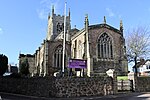Sileby railway station
Beeching closures in EnglandDfT Category F2 stationsFormer Midland Railway stationsIncomplete lists from March 2020Pages with no open date in Infobox station ... and 7 more
Railway stations in Great Britain closed in 1968Railway stations in Great Britain opened in 1840Railway stations in Great Britain opened in 1994Railway stations in LeicestershireRailway stations served by East Midlands RailwayReopened railway stations in Great BritainUse British English from March 2015

Sileby railway station serves the industrial village of Sileby in Leicestershire, England. The station is located on the Midland Main Line, 106 miles 50 chains (171.6 km) north of London St Pancras.
Excerpt from the Wikipedia article Sileby railway station (License: CC BY-SA 3.0, Authors, Images).Sileby railway station
Bradgate Close, Charnwood
Geographical coordinates (GPS) Address External links Nearby Places Show on map
Geographical coordinates (GPS)
| Latitude | Longitude |
|---|---|
| N 52.731227777778 ° | E -1.1095611111111 ° |
Address
Sileby
Bradgate Close
LE12 7UW Charnwood
England, United Kingdom
Open on Google Maps








